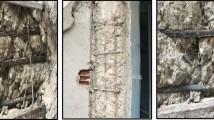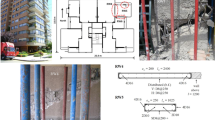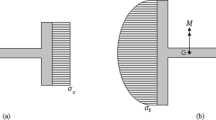Abstract
The large inelastic shear modification factors proposed in Eurocode for ductile RC walls have been verified and modified. Due to this large amplification, which has, in the past, been ignored, and still is, by many designers, RC walls with insufficient shear resistance have been designed and built. In order to study the seismic vulnerability of such walls, a model was proposed, which takes into account both inelastic shear behaviour and inelastic shear-flexural interaction. It is based on the multiple-vertical-line-element macro model. An additional shear spring, which accounts for aggregate interlock , dowel action and horizontal reinforcement resistance, is incorporated into each of the vertical springs. The model successfully simulated the response of a five-storey coupled wall that was tested on the shaking table under bi-axial excitation . The shear resisting mechanisms within the cracks were adequately modelled up until the tension shear failure of both piers.
Access this chapter
Tax calculation will be finalised at checkout
Purchases are for personal use only
Similar content being viewed by others
References
Blakeley RWG, Cooney RC, Megget LM (1975) Seismic shear loading at flexural capacity in cantilever wall structures. Bull N Z Natl Soc Earthq Eng 8(4):278–290
Boroschek R, Bonelli P (2014) Lessons from the Chile 2010 earthquake for performance based design and code development. In: Fischinger M, Stojadinović B (ed) Performance-based seismic engineering – vision for an earthquake resilient society. Springer
CEN (2004) Eurocode 8 – design of structures for earthquake resistance. Part 1: general rules, seismic actions and rules for buildings. European standard EN 1998–1, Dec 2004, European Committee for Standardization, Brussels
Chen S, Kabeyasawa T (2000) Modeling of reinforced concrete shear wall for nonlinear analyses. In: Proceedings of the 12th WCEE, New Zealand Society of Earthquake Engineering, Auckland
Dulacska H (1972) Dowel action of reinforcement crossing cracks in concrete. ACI Struct J 69(12):754–757
EERI (2006) News of the membership – blind prediction contest winners. EERI Newslett 40(9):4
Elwood KJ, Moehle JP (2003) Shake table tests and analytical studies on the gravity load collapse of reinforced concrete frames, PEER report 2003/01, University of California, Berkeley, EERI Newsl (2006), 40(9):4
Fischinger M, Isaković T, Kante P (2006) Shaking table response of a thin H-shaped coupled wall. In: Managing risk in earthquake country – 100th anniversary earthquake conference: centennial meeting, San Francisco. Earthquake Engineering Research Institute, Berkeley, CD ROM
Fischinger M, Kramar M, Isaković T, (2008) Using macro elements to predict near-collapse performance of two typical RC building structural systems with lightly reinforced walls and slender precast columns. In: Proceedings of the 14th world conference on earthquake engineering, Beijing, CD ROM
Fischinger M, Rejec K, Isaković T (2010) Seismic behavior of RC structural walls and Eurocode 8 provisions. In: Proceedings of the 9th US National and 10th Canadian conference on earthquake engineering, Oakland, Earthquake Engineering Research Institute, Canadian Association for Earthquake Engineering, Ottawa
Kabeyasawa T (1997) Design of RC shear walls in hybrid wall system. In: Proceedings, Fourth Joint Technical Coordinating Committee, U.S.-Japan cooperative seismic research on composite and hybrid structures, Monterey
Kante P (2005) Seismic vulnerability of RC structural walls (in Slovenian). Ph.D. Dissertation, University of Ljubljana
Keintzel E (1990) Seismic design shear forces in RC cantilever shear wall structures. Eur Earthq Eng 3:7–16
Kim Y, Kabeyasawa T, Matsumori T, Kabeyasawa T (2011) Numerical study of a full-scale six-storey reinforced concrete wall-frame structure tested at E-Defense. Earthq Eng Struct Dyn 41(8):1217–1239. doi:10.1002/eqe.1179
McKenna F, Fenves GL (2007) Open system for earthquake engineering simulation, Pacific Earthquake Engineering Research Center, Berkeley http://opensees.berkeley.edu
Orakcal K, Massone LM, Wallace JW (2006) Analytical modeling of reinforced concrete walls for predicting flexural and coupled shear-flexural responses, PEER report 2006/07. University of California, Berkeley
Rejec K (2011) Inelastic shear behaviour of RC structural walls under seismic conditions (in Slovenian). PhD dissertation, University of Ljubljana
Rejec K, Isaković T, Fischinger M (2012) Seismic shear force magnification in RC cantilever structural walls, designed according to Eurocode 8. Bull Earthq Eng 10(2):567–586. doi:10.1007/s10518-011-9294-y
Vecchio FJ, Collins MP (1986) The modified compressional-field theory for reinforced concrete elements subjected to shear. ACI J 83(22):219–231
Vecchio FJ, Lai D (2004) Crack shear-slip in reinforced concrete elements. J Adv Concr Technol 2(3):289–300
Vintzeleou EN, Tassios TP (1987) Behavior of dowels under cyclic deformations. ACI J 84(1):18–30
Wallace JW, Moehle JP (1993) Evaluation of ductility and detailing requirements of bearing wall buildings using data from the March 3, 1985, Chile earthquake. Earthq Spectra 9(1):137–156
Wood SL (1991) Performance of reinforced concrete buildings during the 1985 Chile earthquake: implications for the design of structural walls. Earthq Spectra 7(4):607–638
Author information
Authors and Affiliations
Corresponding author
Editor information
Editors and Affiliations
Rights and permissions
Copyright information
© 2014 Springer Science+Business Media Dordrecht
About this chapter
Cite this chapter
Fischinger, M., Rejec, K., Isaković, T. (2014). Inelastic Shear Response of RC Walls: A Challenge in Performance Based Design and Assessment. In: Fischinger, M. (eds) Performance-Based Seismic Engineering: Vision for an Earthquake Resilient Society. Geotechnical, Geological and Earthquake Engineering, vol 32. Springer, Dordrecht. https://doi.org/10.1007/978-94-017-8875-5_24
Download citation
DOI: https://doi.org/10.1007/978-94-017-8875-5_24
Published:
Publisher Name: Springer, Dordrecht
Print ISBN: 978-94-017-8874-8
Online ISBN: 978-94-017-8875-5
eBook Packages: Earth and Environmental ScienceEarth and Environmental Science (R0)




